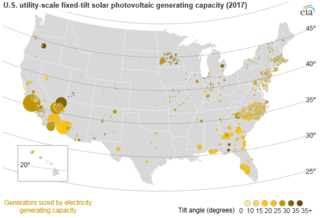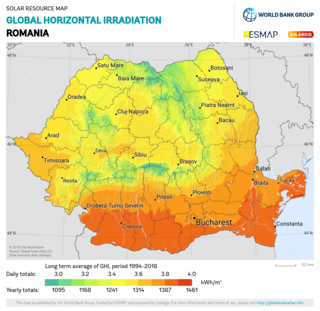
Nevada Solar One is a concentrated solar power plant, with a nominal capacity of 64 MW and maximum steam turbine power output up to 72 MW net (75 MW gross), spread over an area of 400 acres (160 ha). The projected CO2 emissions avoided is equivalent to taking approximately 20,000 cars off the road. The project required an investment of $266 million USD, and the project officially went into operation in June 2007. Electricity production is estimated to be 134 GWh (gigawatt hours) per year.

Many countries and territories have installed significant solar power capacity into their electrical grids to supplement or provide an alternative to conventional energy sources. Solar power plants use one of two technologies:

Solar power in Australia is a fast growing industry. As of March 2021, Australia's over 2.77 million solar PV installations had a combined capacity of 21,352 MW photovoltaic (PV) solar power, of which at least 4,082 MW were installed in the preceding 12 months. In 2019, 59 solar PV projects with a combined capacity of 2,881 MW were either under construction, constructed or due to start construction having reached financial closure. Solar accounted for 9.9% of Australia's total electrical energy production in 2020.

There are several solar power plants in the Mojave Desert which supply power to the electricity grid. Insolation in the Mojave Desert is among the best available in the United States, and some significant population centers are located in the area. These plants can generally be built in a few years because solar plants are built almost entirely with modular, readily available materials. Solar Energy Generating Systems (SEGS) is the name given to nine solar power plants in the Mojave Desert which were built in the 1980s, the first commercial solar plant. These plants have a combined capacity of 354 megawatts (MW) which made them the largest solar power installation in the world, until Ivanpah Solar Power Facility was finished in 2014.

Spain is one of the first countries to deploy large-scale solar photovoltaics, and as of 2018, is the first country for concentrated solar power (CSP) in the world.
Acciona Energy, a subsidiary of Acciona based in Madrid, is a Spanish company developing renewable energy projects, including small hydro, biomass, solar energy and thermal energy, and the marketing of biofuels. It also has assets in the field of co-generation and wind turbine manufacture. As of 2007, it is carrying out research projects to produce hydrogen from wind power and to manufacture more efficient photovoltaic cells.
The Monte Alto photovoltaic power plant in Spain has a generating capacity of 9.55 megawatts peak (MWp) and will generate 14 million kilowatt-hours of electricity per annum. It cost 65 million euros [US$87 million].

Solar power in the United States includes utility-scale solar power plants as well as local distributed generation, mostly from rooftop photovoltaics. As of the end of 2020, the United States had 97,275 megawatts (MW) of installed photovoltaic and concentrated solar power capacity combined. In 2018, utility scale solar power generated 66.6 terawatt-hours (TWh), 1.66% of total U.S. electricity. During the same time period total solar generation, including estimated small scale photovoltaic generation, was 96.1 TWh, 2.30% of total U.S. electricity. In terms of total cumulative installed capacity, by year end 2017 the United States ranked 2nd in the world behind China. In 2016, 39% of all new electricity generation capacity in the country came from solar, more than any other source and ahead of natural gas (29%). By 2015, solar employment had overtaken oil and gas as well as coal employment in the United States. In 2016, more than 260,000 Americans were employed in the solar industry.

The renewable-energy industry is the part of the energy industry focusing on new and appropriate renewable energy technologies. Investors worldwide have paid greater attention to this emerging industry in recent years. In many cases, this has translated into rapid renewable energy commercialization and considerable industry expansion. The wind power and solar photovoltaics (PV) industries provide good examples of this.

Solar power in Romania had an installed capacity of 1,374 megawatt (MW) as of the end of 2017. The country had in 2007 an installed capacity of 0.30 MW, which increased to 3.5 MW by the end of 2011, and to 6.5 MW by the end of 2012. However, the record year of 2013 was an exception, and new installation fell back from 1,100 MW to a moderate level of 69 MW in 2014.

Solar power in California includes utility-scale solar power plants as well as local distributed generation, mostly from rooftop photovoltaics. It has been growing rapidly because of high insolation, community support, declining solar costs, and a Renewable Portfolio Standard which requires that 33% of California's electricity come from renewable resources by 2020, and 60% by 2030. Much of this is expected to come from solar power via photovoltaic facilities or concentrated solar power facilities.

Solar power in Arizona has the potential to, according to then-Governor Janet Napolitano, make Arizona "the Persian Gulf of solar energy". In 2012, Arizona had 1,106 MW of photovoltaic (PV) solar power systems, and 6 MW of concentrated solar power (CSP), bringing the total to over 1,112 megawatts (MW) of solar power. As an example, the Solana Generating Station, a 280 MW parabolic trough solar plant, when commissioned in 2013, was the largest parabolic trough plant in the world and the first U.S. solar plant with molten salt thermal energy storage.
The Blythe Mesa Solar Power Project, also known as the Blythe Solar Energy Center, is a 235 megawatt (MWAC) photovoltaic power plant near the city of Blythe in Riverside County, California. It occupies about 2,000 acres of public land managed by the Bureau of Land Management in the Mojave Desert. The construction uses CdTe thin film panels from the U.S. firm First Solar, and the majority of the output is being sold to Kaiser Permanente and Southern California Edison under 20-year power purchase agreements.
The Sault Ste. Marie Solar Park near Sault Ste. Marie, Ontario, Canada, in 2011 became Canada's second largest photovoltaic plant with an installed capacity of 68 MWp.

The Perovo Solar Park is a 100 MWp photovoltaic power station located at Perovo, Simferopol Raion, Crimea, Ukraine. As of July 2012 it is the world's fourth-largest solar farm, and is made up of 440,000 solar panels. It is owned by Activ Solar, and the final 20 MW stage was completed on December 29, 2011.

Solar power in the Netherlands has an installed capacity of around 4,300 megawatt (MW) of photovoltaics as of the end of 2018. Around 1,397 MW of new capacity was installed during 2018, the second highest figure in Europe for that year.
The Catalina Solar Project is a 143.2 megawatt (MW) photovoltaic power station located near Bakersfield, Kern County, California, owned by enXco, an EDF Énergies Nouvelles Company. It covers area of 445 hectares.












